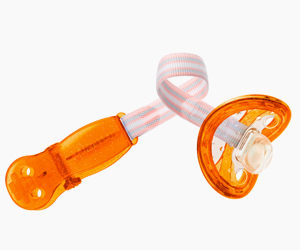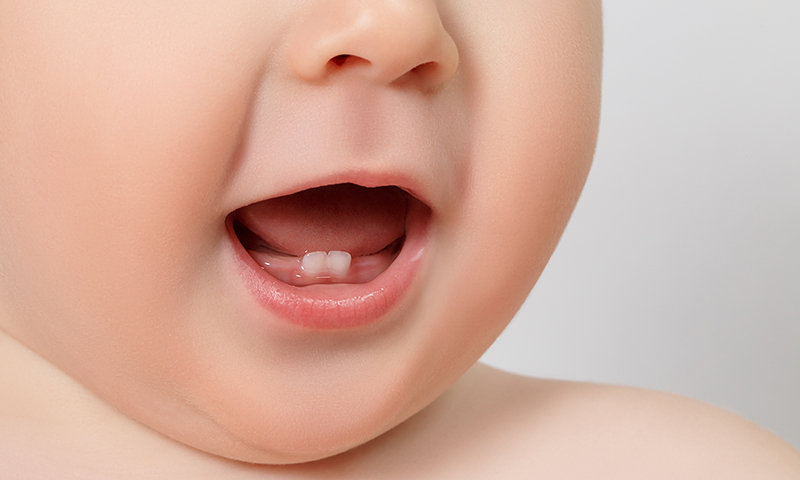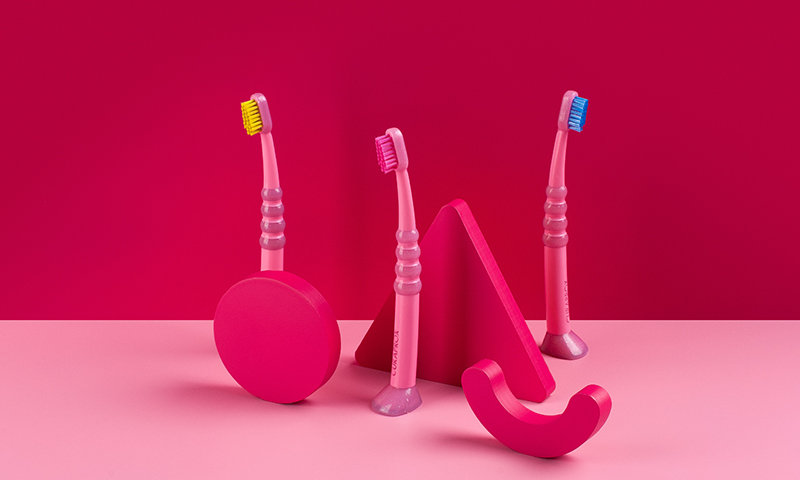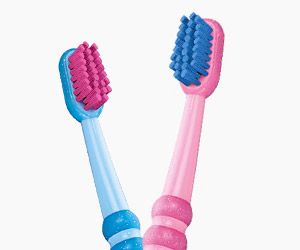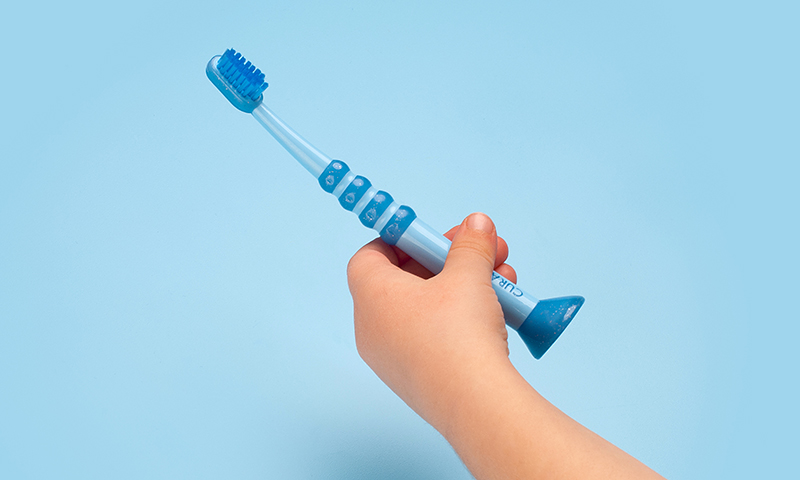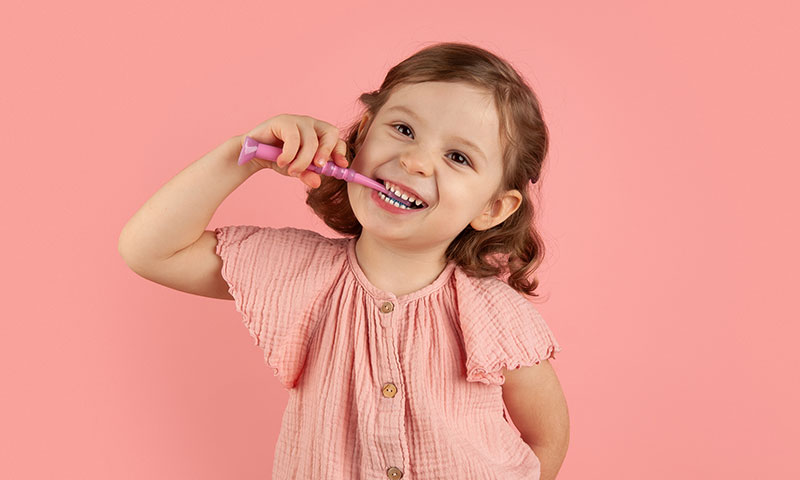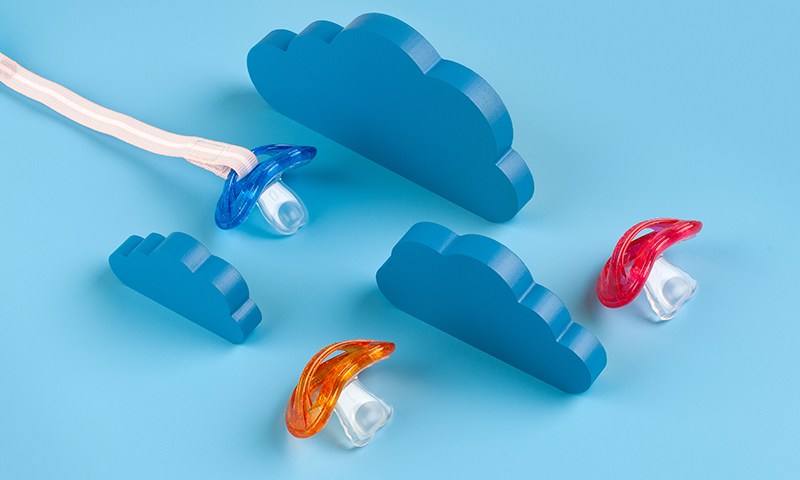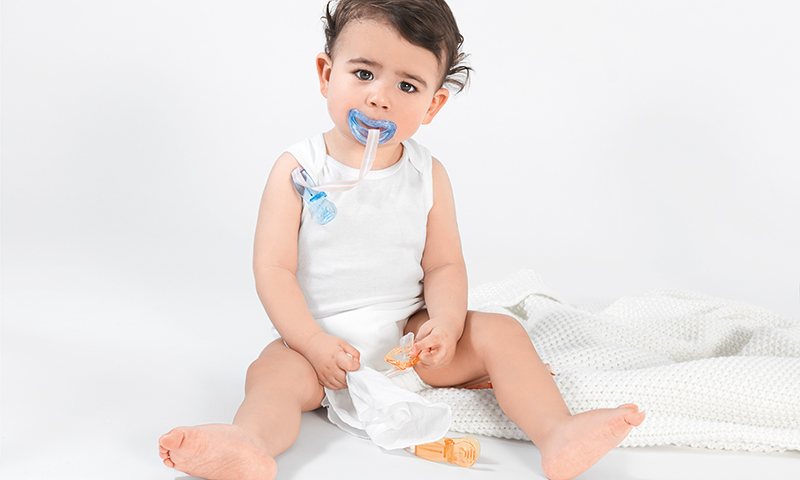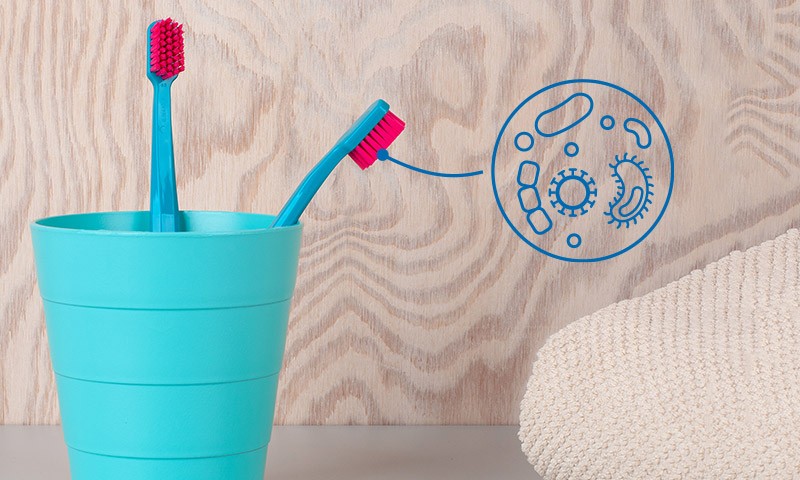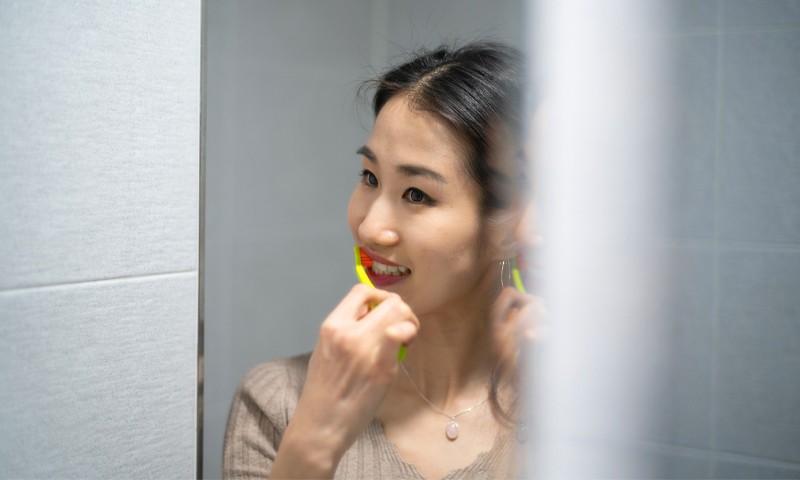Why this guide?
How do I take care of my child's teeth?
This guide is for you if you want to:
- Feel secure you’re laying the foundations for your child to enjoy good oral health – and good overall health – for the rest of their life
- Show your child – right from the start – that looking after their teeth and gums can be fun
Introduction
Looking after your baby's teeth
How do I take care of my baby's teeth?
When your baby’s first little tooth breaks through, it’s a milestone in their development.
It’s also a time when great care is needed to give them the best possible start to their oral health journey.
Oral health for babies:the risk of misaligned teeth
Tooth decay in a milk tooth is a bad sign for your child’s future dental health.
Almost 14% of three-year-olds have dental caries – small holes – in their teeth.
If milk teeth are lost too early because of tooth decay and caries, it can shift the position of their permanent teeth. This leads to misaligned teeth, which then need to be corrected by an orthodontist.
And when the milk tooth falls out, the tooth decay-causing bacteria remain… which can then go on to attack the permanent teeth.
IMPORTANT: If you have any concerns at all about your baby’s milk teeth, please go and see a dentist. The sooner you see your dentist, the more chance you have of avoiding dental problems when your child gets older.
“Milk teeth are an important placeholder for the adult teeth. They promote speech development and the development of the jaw and face. If a decaying milk tooth is not treated, it can become inflamed and damage the surrounding bone and the adult tooth below it.”
Why are milk teeth so delicate?
Milk teeth are not only smaller then permanent teeth but also far less robust.
The enamel is softer and is only about half as thick, which explains:
- Why milk teeth are so easily damaged by erosion
- Why it’s so easy for bacteria to attack
- And why even the very young can suffer from toothache
Baby teeth care: brushing first teeth, teething, gum care
In summary, it’s crucial you do everything within your power to take great care of your baby’s oral health… right from the very start.
Keep reading to find out exactly how to help your child easily move towards – and enjoy – regular brushing…
From birth to 6 month
Oral health from birth
When should I start cleaning my baby's mouth?
Bacteria – that feed on the lactose contained in breast milk or baby food – accumulate in your baby’s mouth from day one.
Gently wipe your baby’s gums and palate with a soft, moistened cloth.
Prepare your child for cleaning tehir teeth with a teething ring... complete with integrated training toothbrush
Before too long, your child will be ready for the perfect next step in their journey to brushing their teeth:
The Curaprox teething ring… complete with integrated training toothbrush to:
- Massage their gums
- Encourage excitement and curiosity… and playfully prepare them for brushing for the first time
In addition, the Curaprox teething ring:
- Takes away teething pain – your baby plays happily… and you’re content
- Features a rattle to awaken the senses…
- … and exciting textures to promote sensory and motor skills
- Is available in two colours – turquoise and blue
- Like all Curaprox BABY products is biofunctional, toxin-free and completely safe to use – please see the “biofunctionality design ethos” section below
Just clip on the Curaprox soother holder to stop the teething ring falling on the floor where it can get dirty. Originally designed for the Curaprox soother, the holder works perfectly to make sure your baby keeps hold of their teething ring.
And when their first tooth arrives... the teething ring keeps taking the pain away
When the first tooth breaks through, it’s a celebration for you…
… but not for your baby. They’re in pain. But there’s no need to reach for the ointment. Just give them the teething ring. They’ll instinctively bite down on it. And it will take their pain away.
We recommend:
From 6 month+
Their first milk tooth
When to start cleaning baby teeth
The first milk tooth usually breaks through around the sixth month mark. Brushing their first tooth is a special moment!
Clean each milk tooth at least once a day with a moistened Curaprox baby toothbrush.
How to brush your baby or toddler's teeht
Put your baby on your lap – with their back to you and their head resting against your chest.
As your child gets older, stand behind them, tilting their head backwards.
Brush their teeth using small circles, making sure you cover all the surfaces.
Baby toothpaste
Toothpaste is optional at this age but, if you do go for it, just use a drop of low-fluoride baby toothpaste with a pleasant taste.
Encourage them to spit it out afterwards. But there’s no need to rinse with water, which would wash away the fluoride.
Curaprox baby toothbrush for joy, peace of mind... and clean teeht
The Curaprox baby toothbrush offers gentle, exceptional cleaning for children aged up to four. And it makes cleaning teeth fun and joyful… so you can enjoy quality parent-child time.
The Curaprox baby toothbrush – developed by Dental Professor Adrian Lussi:
- Features 5,500 extra-fine, gentle Curen® filaments that prevent injuries to the delicate oral mucosa – the tissue that lines the mouth…
- … a compact rubberised brush head to reach all areas of the mouth…
- … a rounded handle that helps children to hold their toothbrush the right way – with gentle pressure – now and forever…
- … and it’s easy for adults to hold as well – just in case your child needs a helping hand
- It comes in three colours – turquoise, blue and pink…
- … it’s recommended by dentists
- … and it’s “toxin-free” – and completely safe to use
We recommend:
The dentist
The first visit to the dentist
Dental advice for babies and toddlers
We recommend you make the first of many visits to the dentist after your baby’s first birthday.
Avoid going to the dentist only when something hurts. This way, your child will learn that regular, routine visits to the dentist are perfectly normal.
Two years+
Oral care from 2+
When should toddlers start brushing teeth?
From your child’s second birthday at the latest, brush their milk teeth twice a day for at least two minutes: once after breakfast and once before bedtime. Use a maximum of a pea-sized amount of low-fluoride children’s toothpaste.
Before you know it, they’ll be happily cleaning their own teeth! Here are the four phases of tooth brushing:
The four phases of tooth brushing
Phase 1: Dependent cleaning – from the first tooth.
You take control of your child’s oral hygiene.
Phase 2: Supported brushing – from two-and-a-half years old.
Your child starts to brush their own teeth. So:
- Start with the chewing surfaces.
- “Paint” circles on the outer surfaces.
- Brush up and down, up and down on the inner surfaces.
- Finish off by thoroughly brush their teeth and gums yourself.
Phase 3: Supervised brushing – from nine-years old.
You regularly check, motivate and support your child with their oral health.
Phase 4: Independent brushing – young adults.
They’re responsible for brushing their teeth and looking after their oral health.
When their first tooth falls out
PLEASE NOTE: Take extra care when the first wobbly milk tooth falls out… and makes room for a permanent tooth.
This usually happens around the age of six. The enamel on new permanent teeth takes about three years to completely harden… so they’re particularly susceptible to decay.
Thorough, gentle oral hygiene during this time is even more important. It’s also time to progress to a specialist junior toothpaste with a higher fluoride content.
Further information
Is it okay to use a dummy
Dummies, soothers, pacifiers… can be an effective way to calm your baby. But conventional dummies are known to make your child more likely to need orthodontic treatment as a teenager.
And children with a crossbite or an open bite are more prone to breathing through the mouth – rather than the nose – which can lead to problems including:
- Disturbed sleep
- Difficulty concentrating
- Poor posture
- Speech disorders
- Hyperactivity…
- … and even heart conditions
The orthodontic dummy that supports natural development
The Curaprox soother, meanwhile – with its distinctive flat suction tip and side wings – is the ultimate orthodontic dummy.
The Curaprox soother – developed by orthodontists:
- Relaxes your baby… without the risk of dental displacement or the danger of jaw deformation
- Prevents your baby’s teeth from moving…
- … and prevents difficulties with their overall health
- Supports – rather than hinders – the natural development of your baby’s teeth, gums, palate and jaw…
- … and supports language development and the natural swallowing process
- Ensures optimal breathing
- And, as such, calms babies – and their parents!
And don’t forget to clip on a Curaprox soother holder so your baby’s soother won’t get lost or dirty!
Three sizes - three colors
Because the jaw develops according to weight and not age, the Curaprox soother is sized based on the weight of your child:
- Soother size 0: Up to 7kg. (0-approx 7 months.)
- Soother size 1: Up to 10kg. (Approx 7-18 months.)
- Soother size 2: Up to 14kg. (Approx 18-36 months.)
We recommend your child gives up on soothers by their third birthday at the latest to aid healthy jaw development.
We recommend:
Further information
Our biofunctionality design ethos
All our Curaprox Baby products are designed using our “biofunctionality” ethos:
- Thinking about cause and effect…
- …creating products to promote growth naturally…
- … to work in harmony with your baby’s development…
- … instead of potentially harming their development
And all our Curaprox Baby products are toxin-free, which means they’re completely harmless for the little ones. No harmful substances, such as Bisphenol A, Phthalate or azo-dyes.
 Swiss premium oral care
Swiss premium oral care










